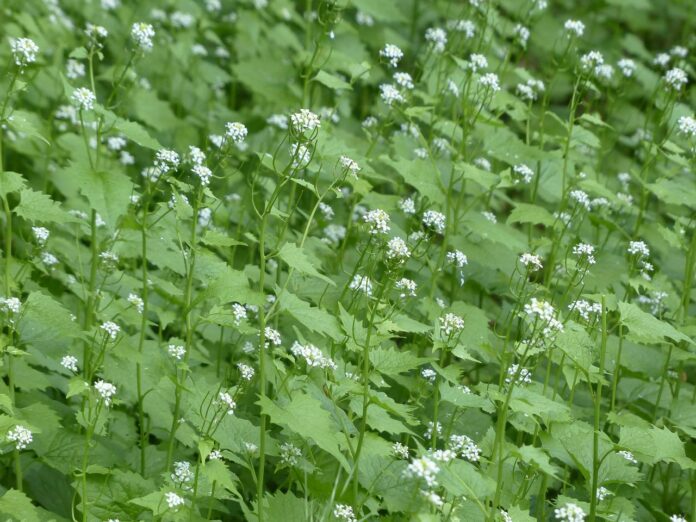Invasive species are often the first plants to leaf out on the forest floor in the spring, which makes it a great time for management in your woodlot. Removing invasive plants gives native plants more sunlight to grow and more space to thrive. Where native plants flourish, wildlife benefits and local ecosystems become healthier and more in balance.
Garlic Mustard
Garlic mustard is an invasive that is capable of establishing dense colonies in woodlots, crowding out native plant species and displacing the wildlife species that depend on them.
It was first introduced in the United States from Europe in 1868 and is now distributed throughout the Northeast and Midwest.
Garlic mustard will start invading a woodlot from the edges of the tree line, around trails and near streams. It is extremely tolerant of shade and it out-competes native plants to spread rapidly via animals, shoes and off-road vehicles. Once mature, an average plant can easily produce over 100 seeds.
There is also some evidence that suggests garlic mustard roots produce a chemical that hinders the growth of nearby plants, according to Ohio State University Extension.
Identification
First-year garlic mustard grows in a basal rosette. The plant consists of three to eight rounded leaves with wavy-toothed margins forming in a circle at the base of the stem. The leaves are wrinkled in appearance and stay green throughout winter.
The plant will produce two to four tall flower stalks in its second year. Plants that have reached maturity are harder to eradicate because they produce seeds. However, they have more identifying characteristics.
Leaves. Garlic mustard leaves are heart-shaped to triangular with wavy-toothed margins. They grow 1-3 inches long and 1-4 inches wide, alternately arranged on the stem. They give off a garlic odor when crushed.
Flowers. Flowers begin appearing in small clusters at the end of each stalk in mid to late spring. They are white with four petals.
Seeds. Seed pods are produced by early to mid-summer. They are 1-2.5 inches long and four-sided. The seeds inside are black, small and develop in a row.
Roots. Garlic mustard has a slender, white taproot.
Controlling Garlic Mustard
Weeding. It seems odd to weed the woods, but it’s an effective practice for eradicating noxious weeds in the spring before they begin flowering. Garlic mustard can be pulled or dug, but it’s important to remove as much of the root as possible. This plant can sprout from fragments that are left behind. Plants should be bagged and burned after they are pulled.
This process will have to be done every year for several years because garlic mustard seed can remain viable in the soil for five or more years.
It’s not recommended to pull plants that have begun to flower as this can perpetuate the spread of garlic mustard to other areas.
However, after the stalks have sprouted before flowers have opened, garlic mustard stalks can be cut a few inches above the soil surface and removed. If this tactic is used, plants will have to be repeatedly checked because new stalks can grow from the remaining plant.
If seedheads have formed, you can cut them into a paper bag to collect them and burn them.
Weed torch. A weed torch may also be utilized to spot-kill newly germinated seedlings. The benefit of using a weed torch is that it can kill tender seedlings without permanently damaging surrounding plants. However, a weed torch should only be used when conditions are wet and not windy so that flames don’t escape the intended area.
Herbicides. Herbicide can be applied to foliage early in the growing season before seed pods form in areas with extensive populations. However, take care not to apply herbicide to desirable plants. It is crucial to spray all of the garlic mustard plants in the targeted area otherwise the ones that survive will grow larger in the absence of competition.
First-year rosettes can also be treated in late fall when conditions are dry and temperatures are above 50F after other plants have gone dormant, which reduces the chances of damaging other plant species.











Garlic mustard is also one of the most delicious wild greens, though some people are allergic to it.
PLease also think long term. Especially if your land management time and resources are limited. I found thought process from Blossey ( https://milliontrees.me/tag/dr-bernd-blossey/#:~:text=Blossey%20and%20his%20collaborators%20measured,Dr.) more informative than almost anything else I have read about trying to eradicate every invader without thinking.